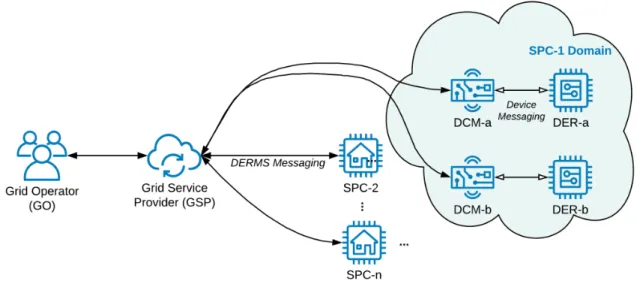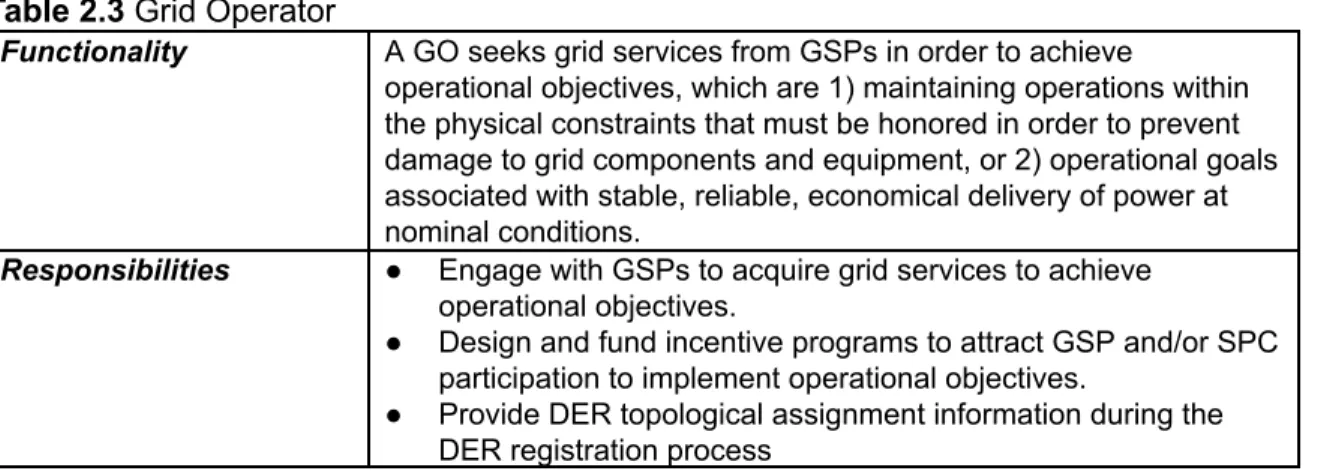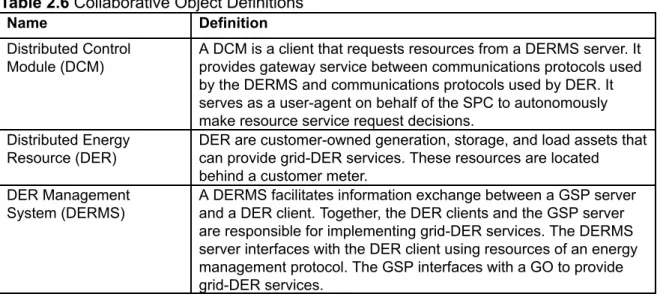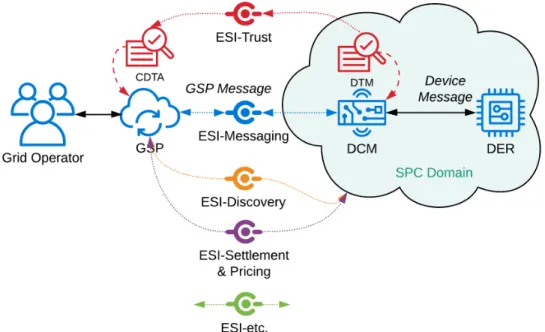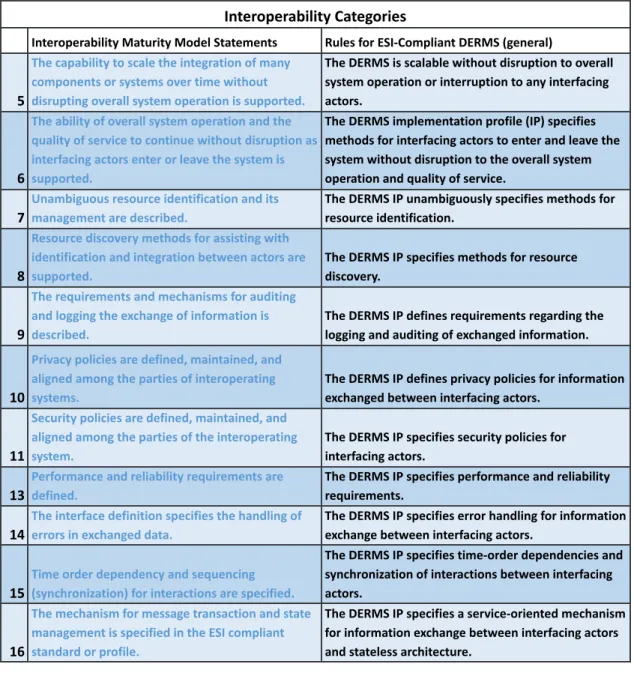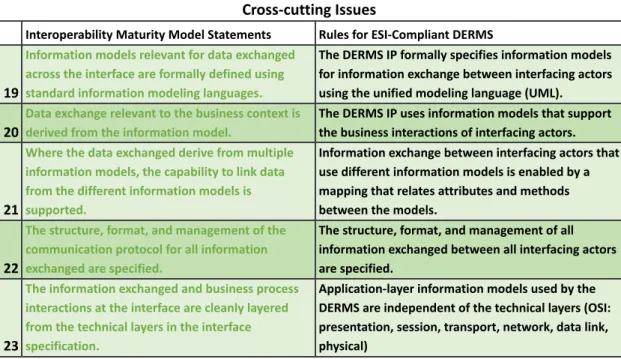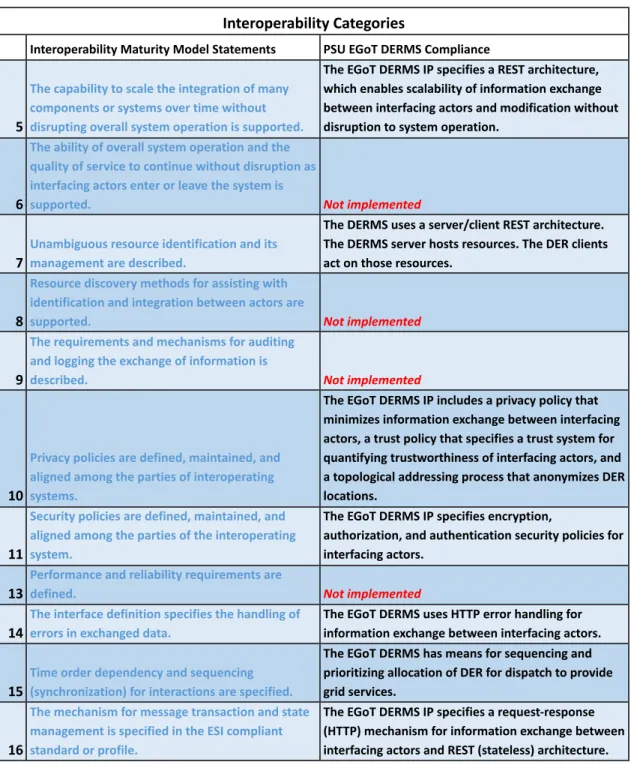Energy Services Interface:
Privacy, Security, Trust, Interoperability
Development of an Energy Services Interface for the EGoT
WORK PERFORMED UNDER AGREEMENT DE-OE0000922
Portland State University 1900 SW 4th Ave Portland, OR 97201
Period of Performance: 7/13/2020 to 9/30/2023
Submitted: January 4, 2024 Revision: 1.0
PRINCIPAL INVESTIGATOR Robert Bass, Ph.D.
503-725-3806 [email protected]
BUSINESS CONTACT Patti Fylling 503-725-6584 [email protected]
SUBMITTED TO U. S. Department of Energy National Energy Technology Laboratory
DOE Project Officer: Mario Sciulli
This report does not contain any proprietary, business sensitive, or other information not subject to public release.
Energy Services Interface:
Privacy, Security, Trust, Interoperability
Development of an Energy Services Interface for the EGoT
WORK PERFORMED UNDER AGREEMENT DE-OE0000922
Portland State University 1900 SW 4th Ave Portland, OR 97201
Period of Performance: 7/13/2020 to 9/30/2023
Submitted: January 4, 2024 Revision: 1.0
PRINCIPAL INVESTIGATOR Robert Bass, Ph.D.
503-725-3806 [email protected]
BUSINESS CONTACT Patti Fylling 503-725-6584 [email protected]
SUBMITTED TO U. S. Department of Energy National Energy Technology Laboratory
DOE Project Officer: Mario Sciulli
This report does not contain any proprietary, business sensitive, or other information not subject to public release.
Energy Services Interface:
Privacy, Security, Trust, Interoperability
This material is based upon work supported by the Department of Energy under Award Number DE-OE0000922.
Disclaimer:This report was prepared as an account of work sponsored by an agency of the United States Government. Neither the United States Government nor any agency thereof, nor any of their employees, makes any warranty, express or implied, or assumes any legal liability or responsibility for the accuracy, completeness, or usefulness of any information, apparatus, product, or process disclosed, or represents that its use would not infringe privately owned rights. Reference herein to any specific commercial product, process, or service by trade name, trademark, manufacturer, or otherwise does not necessarily constitute or imply its endorsement,
recommendation, or favoring by the United States Government or any agency thereof. The views and opinions of
Revision History
Date Version Description Author
7/12/22 1.0 Document creation. Transfer of relevant content from EGoT DERMS IP
R. Bass
8/4/22 1.1 Definitions update R. Bass
11/3/22 1.2 Edit 3.2: SOGP R. Bass
10/2/23 1.3 Definitions update R. Bass
12/13/23 1.4 Update DERMS compliance with IMM in tables 5.3, 5.4
R. Bass 12/14/23 2.0 Document update and final review R. Bass
Energy Services Interface:
Privacy, Security, Trust, Interoperability
Background 4
Acronyms 5
1 Energy Services Interface 6
2 Background 7
2.2 Participants & Definitions 7
2.2.1 Functionalities and Responsibilities 8
2.2.2 Definitions 9
3 The ESI: A Bi-Directional, Service-Oriented, Logical Interface 10
3.1 The Objectives of the ESI 10
3.2 Service-Oriented Grid Participation 11
4 ESI Rules: Privacy, Security, and Trust 12
4.1 ESI Privacy Policy 12
4.1.1 Privacy of Information 12
4.1.2 Privacy of Agency 12
4.2 ESI Security Policy 13
4.3 ESI Trust Policy 13
5 ESI Alignment with the Interoperability Maturity Model 15
6 A Call for an ESI Specification 20
Appendix A Grid-DER Services 21
Background
This document originated as part of a U.S. DOE-funded project to develop a set of rules known as the Energy Services Interface (ESI), which
… establishes a bi-directional, service-oriented, logical interface to support secure, trustworthy information exchange between an aggregator and distributed energy resources (DERs). These exchanges facilitate energy interactions between the DERs and the aggregator, thereby allowing the aggregator to provide grid services through dispatch of the DERs.
The ESI serves as an umbrella, ensuring the information exchange between an
aggregator and DER owners conforms to expectations: protect privacy, provide security, develop trustworthiness, and ensure interoperability.
DERMS developers use the ESI to ensure that information exchange meets these expectations. The expectation is that developers will create DERMS based on a service-oriented architecture, and that the DERMS will protects customer privacy by limiting information exchange and ensuring customer autonomy, provides security by adopting best practices, develops quantifiable trustworthiness, and ensures
interoperability by aligning the design with the categories and cross-cutting issues of the Interoperability Maturity Model.
The ESI promotes DERMS design practices that ensure private, secure, trustworthy information exchange and interoperability between aggregators and DERs, thereby encouraging large-scale DER adoption and stimulating technological innovations within a dynamic Energy Grid of Things (EGoT) ecosystem of application developers, DERMS operators, and DER manufactures.
Acronyms
ACE Area Control Error ACL Access Control List DCM Distributed Control Module DER Distributed Energy Resource DERMS DER Management System DLC Direct Load Control DTM Distributed Trust Model EGoT Energy Grid of Things ESI Energy Services Interface
FOA Funding Opportunity Announcement GMLC Grid Modernization Laboratory Consortium
GO Grid Operator
GSP Grid Service Provider
HTTP(S) Hypertext Transfer Protocol (Secure) IMM Interoperability Maturity Model IP Implementation Profile
PII Personally Identifiable Information SOA Service Oriented Architecture SOGP Service-Oriented Grid Participation
SPC Service-Provisioning Customer, i.e. a DER program participant TLS Transport Layer Security
REST Representational State Transfer UML Unified Modeling Language
1 Energy Services Interface
The objectives of the Energy Services Interface are to ensure private, secure, and trustworthy information exchange between Grid Service Providers (GSPs) and Service Provisioning Customers (SPCs) and to stimulate technological innovations within a large and dynamic EGoT ecosystem. Large-scale adoption of DERs will be necessary to dispatch effective grid-DER services, and to stimulate technological innovations in DER, DERMS (DER Management Systems), and grid service programs. The ESI promotes these objectives by advancing a set of rules and interoperability requirements that define bi-directional, service-oriented, logical interfaces between GSPs and DERs, with
expectations for privacy, security, and trust .1
The ESI rules and interoperability requirements establish boundaries between SPCs and GSPs that delineate the functions and responsibilities that must be implemented by the developers of EGoT ecosystem products. In this document, we present rules and interoperability requirements under the themes of privacy, security, and trust. These rules impose constraints on the implementation of a DERMS. We emphasize: the rules and requirements of the ESI still must be developed and agreed upon within a
collaborative forum that includes a diversity of stakeholders from the EGoT ecosystem.
The ESI interoperability requirements are based on the Interoperability Maturity Model (IMM) , developed by the Grid Modernization Laboratory Consortium Interoperability2 Project 1.2.2. These interoperability requirements are in the categories of: Configuration and Evolution, which include resource identification and scaling; Safety and Security, which include failure mode policies as well as privacy and security; Operation and Performance, which include performance, reliability, and error handling; Organizational criteria relate to the business, jurisdictional, and regulatory requirements; Informational criteria related to information models and data alignment; and, Technical criteria related to information representation, alignment between interoperating parties, and the digital exchange of data.
By emphasizing private, secure, and trustworthy information exchange, and by mandating a service-oriented and interoperable architecture, the ESI promotes the development of an EGoT ecosystem that motivates SPC participation and technological innovation. Interoperability will encourage innovation by reducing barriers to entry and increasing confidence of stakeholders. SPCs will be willing to participate in grid-DER service programs that establish trust and emphasize customer choice. Large-scale SPC participation ensures GSPs have ample DER resources to provide grid services that have significant impact on grid reliability and reduce electricity cost for consumers. This in turn signals economic opportunities that encourage innovation, resulting in the development of a robust EGoT ecosystem.
2M.R. Knight, D. Narang, J.T. Kolln, A. Khandekar, S.E. Widergren, B. Nordman,Interoperability Maturity Model A Qualitative and Quantitative Approach for Measuring Interoperability, Pacific Northwest National Laboratory, PNNL-29683, January 2020
1S. Widergren, R. Melton, A. Khandekar, B. Nordman and M. Knight, "The Plug-and-Play Electricity Era:
Interoperability to Integrate Anything, Anywhere, Anytime," in IEEE Power and Energy Magazine, vol. 17, no. 5, pp. 47-58, Sept.-Oct. 2019
2 Background
An EGoT is composed of multiple actors, each with their own responsibilities and objectives, shown in Figure 2.1. The Grid Operator (GO) is responsible for procuring grid-DER services from one or more GSPs, with the objective of using these services to maintain power system reliability. The GSP is responsible for aggregating DER, with the objective of using the aggregation to provide grid-DER services.
Grid-DER services are essential reliability services that can be provided through dispatch of DER aggregations. Grid-DER services fall into six categories: energy scheduling, reserve, regulation, emergency management, frequency response, and voltage management. These are described in Appendix A .3
Figure 2.1A simplified representation of the EGoT actors and the information exchange pathways between them.
SPC are responsible for registering their DER with a GSP prior to participating in grid services. The SPCs’ objectives are to maximize their own utility. SPCs set their comfort limits, which determine how aggressively or conservatively the SPCs would like their DERs to participate in GSP programs. These determinations are managed by the
Distributed Control Module (DCM), which serves as an agent on behalf of the SPC and a gateway between the protocols used by the GSP and the DER, if they are different. The DCM is the client of the DERMS server.
2.2 Participants & Definitions
An EGoT ecosystem encompasses multiple actors and relies on specific definitions for many terms. An understanding of the ecosystem will occur best by studying thefunctions
& responsibilitiestables and thedefinitionstables presented in sections 2.2.1 and 2.2.2, and referring back to these tables as each new figure is introduced. Tables 2.1 and 2.2 present the main participants that interact through information exchange to enable the
3Grid-DER services definitions have been proposed by the Grid Modernization Laboratory Consortium (GMLC).
dispatch of DER to provide grid-DER services. The number of participants varies depending on the use case.
Participants are classified asActors, which are persons or other external systems; and Collaborative Objects, which include interacting components other than Actors.
Table 2.1Actors
Name Type
Grid Operator organization
Grid Services Provider organization
Service Provisioning Customer person or organization
Table 2.2Collaborative Objects
Name Type
DER management system (DERMS) application
Distributed Control Module agent
Distributed Energy Resource device
Energy Services Interface rules
2.2.1 Functionalities and Responsibilities
This subsection presents the functionalities and responsibilities of the system actors and collaborative objects discussed within this document.
Actors
Table 2.3Grid Operator
Functionality A GO seeks grid services from GSPs in order to achieve
operational objectives, which are 1) maintaining operations within the physical constraints that must be honored in order to prevent damage to grid components and equipment, or 2) operational goals associated with stable, reliable, economical delivery of power at nominal conditions.
Responsibilities ● Engage with GSPs to acquire grid services to achieve operational objectives.
● Design and fund incentive programs to attract GSP and/or SPC participation to implement operational objectives.
● Provide DER topological assignment information during the DER registration process
Table 2.4Grid Service Provider
Functionality A GSP provides grid services to a GO through the dispatch of DER that have subscribed to a GO program. Aggregation and dispatch are achieved using a DERMS. Grid services are the means by which a GO achieves operational objectives.
Responsibilities ● Provide grid services to GOs.
● Evaluate its aggregation of DER assets to determine a menu of grid services to offer to GOs, prioritized based on the priority operational objectives of GOs.
● Entice SPCs to subscribe to DER aggregation programs
● Exchange information according to the EGoT Server/client IP.
Table 2.5Service Provisioning Customer
Functionality An SPC is a electric utility customer who owns one or more devices that can serve as a DER, and who is interested in providing those DER to a GSP through an aggregation program.
Responsibilities ● Subscribe to GO or GSP programs so that their DERs can be managed in order to provide value to the grid
● Ensure their DER are available to request services from GSPs
● Communicate prioritized operational objectives with the GO
2.2.2 Definitions
Below are definitions of collaborative objects that are required to properly interpret this document.
Table 2.6Collaborative Object Definitions
Name Definition
Distributed Control Module (DCM)
A DCM is a client that requests resources from a DERMS server. It provides gateway service between communications protocols used by the DERMS and communications protocols used by DER. It serves as a user-agent on behalf of the SPC to autonomously make resource service request decisions.
Distributed Energy Resource (DER)
DER are customer-owned generation, storage, and load assets that can provide grid-DER services. These resources are located behind a customer meter.
DER Management System (DERMS)
A DERMS facilitates information exchange between a GSP server and a DER client. Together, the DER clients and the GSP server are responsible for implementing grid-DER services. The DERMS server interfaces with the DER client using resources of an energy management protocol. The GSP interfaces with a GO to provide grid-DER services.
3 The ESI: A Bi-Directional, Service-Oriented, Logical Interface
The ESI rules address information exchange at the multiple logical interfaces between a GSP and SPCs’ DERs. Figure 2.1 conceptually illustrates several of these, such as trust (red) and resource messaging (blue). Others may include device discovery (orange), and logging & pricing (purple), among others.
Figure 3.1The ESI is a set of rules that regulate the multiple interfaces between a GSP and an SPC including, but not limited to, resource messaging (blue), trust (red),
discovery (orange), and logging & pricing (purple).
In general, a logical interface is a pathway entity through which information is
exchanged. This entity is addressable and the information consists of a specific set of attributes. A bi-directional logical interface is one that supports information exchange between a server and a client, wherein both actors send and receive information.
3.1 The Objectives of the ESI
The objectives of the ESI are to:
1. ensure private, secure, trustworthy information exchange between GSPs and SPCs in order to promote dispatch of grid-DER services; and,
2. stimulate technological innovations in order to foster a large and dynamic EGoT ecosystem.
Discussed in the following subsections are the rules of the ESI, categorized under privacy,security, andtrust.Motivation for these responsibilities derive from
conversations, publications4 5, , and our own experience developing the EGoT DER server/client management system. These rules are a work-in-progress. The rules are intended to
1. ensure trustworthy information exchange between GSPs and SPCs
2. clearly define responsibilities for privacy and security between GSPs and SPCs 3. facilitate automated information exchange between GSPs and SPCs’ DERs 4. limit information exchange between GSPs and DERs and other external parties 5. obscure SPCs’ management of their DERs from the GSP
6. be extensible to new EGoT technologies
3.2 Service-Oriented Grid Participation
A system that provides a bi-directional, service-oriented, logical interface is one that adopts a service-oriented architecture (SOA) for information exchange. In SOA systems, a service provider (the GSP’s DERMS server) creates resource services. It then makes these resource services available to service requesters (the SPC client) via a registry.
The client identifies one or more resource services from within the registry, then binds to the server in order to invoke the service(s). By adopting a SOA, the EGoT DERMS ensures that SPCs retain the choice to participate in grid-DER services, thereby leaving the client in control of their assets and not permitting the GSP to have direct control of an SPC’s DER. The customer can then choose to participate in the services of a
Service-Oriented Grid Participation (SOGP) utility program when they choose to do so, in contrast to a Direct Load Control (DLC) utility program wherein the utility instigates all services.
SOA relies on layered decomposition, wherein a system is decomposed into strata of organized layers that interact with each other through information exchange. This
abstracts the various aspects of a complex system into separate manageable layers, the development of which can be driven by innovation from respective domain experts.
Layered decomposition permits simultaneous development of all the system layers, so long as layer separation is clear and modularity is well-defined. It also separates the intent of a message from the execution of the message; how one layer responds to a message received from another is the responsibility of the receiving layer, to the extent that the response satisfies the requirements of the message. For example, an asset aggregator need not be concerned with how an SPC reduces its aggregate load, so long as its energy consumption is reduced. However, in order for layered decomposition to work, interoperability is required to ensure proper information exchange and responses among layers.
5Funding Opportunity Announcement: DE-FOA-0002092, “Electric Grid of Things - Attaining Resilience Objectives With Networks of Sensing Intelligent Machines,” U.S. Department of Energy (DOE), Office of Electricity, June 2019
4Interoperability Strategic Vision: A GMLC White Paper. PNNL-27320, Pacific Northwest National Laboratory, Richland, Washington, March 2018
4 ESI Rules: Privacy, Security, and Trust
The ESI rules establish boundaries between SPCs and GSPs that delineate the functions and responsibilities of each party. Below, we propose rules under the themes of privacy, security, and trust. These proposed rules impose constraints on the
implementation of the DERMS.
4.1 ESI Privacy Policy
The purpose of the following ESI privacy rules is to ensure that the DERMS respects SPCs’ privacy. The notion of privacy encompasses two concepts: privacy of information and privacy of agency. In general, people have expectations that their personal
information and behaviors shall be sequestered from the view of other people, and that their personal decisions shall be unimpeded by interference from other people. In the context of a DERMS aggregation program, the program shall be designed such that SPCs can expect that their personally identifiable information (PII) and energy
consumption behaviors will remain private, and that their ability to use their DER as they choose shall not be impeded.
4.1.1 Privacy of Information
● The GSP shall not record or discern SPC usage patterns.
● The GSP shall limit exchange of SPC PII to the minimum required to implement a particular resource service.
● The GSP shall not know the identity (e.g. appliance type, make, model) of SPCs’
DERs; only relevant DER resource service attributes may be exposed.
● The GSP shall not have access to any information related to DERs that are not registered with its DERMS program.
● The GSP shall anonymise DER topological information to the extent necessary for providing a particular grid service.
● The GSP shall not expose the PII of SPCs to third parties, including other SPCs.
4.1.2 Privacy of Agency
● The SPC shall initiate all resource service requests between the GSP and SPC.
● The SPC shall be able to decommit from a scheduled resource service at any time
● The SPC shall not be penalized (e.g. blocked from future participation, fined, deprioritized) for decommitting from a scheduled resource service.
● GSPs shall accept all DER types, so long as they qualify to receive resource service responses.
● The GSP shall not present information to an SPC that reveals the agency behaviors of another SPC.
● The GSP should engage SPCs on an opt-in basis.
● The GSP may engage SPCs on an opt-out basis, if the local regulating authority permits opt-out engagement after stakeholder engagement and appropriate community education.
4.2 ESI Security Policy
The following proposed ESI rules ensure that the DERMS applies state-of-the-art, proven cybersecurity measures, as declared by a qualified third party such as the
National Institute of Standards and Technology. Security measures apply to encryption of data, authorization for registration and requests, and authentication of clients and
messages.
Though often considered to be under the same umbrella, Security and Trustworthiness are presented as two distinct categories in the context of the EGoT. Security pertains to preventative measures while Trustworthiness encompasses detective measures. The preventative measures include the application of encryption, authorization, and authentication. Detective measures provide a means to identify abnormal messaging where preventative measures fail. The detective measures are provided by the DTM system, as described in the next section.
● Encryption
○ Application layer using HTTPS (via TLS)
● Authorization
○ Registration
■ An out-of-band procedure (not through the DERMS server)
■ SPC registration with GSP (a utility or third party aggregator)
■ Provides explicit SPC and DER authorization
○ Access control lists (ACL)
■ To determine if client access to a specific resource service is permitted (denied only if not listed, not explicitly).
● Authentication
○ of messages via TLS
○ of clients (DCM)
■ Required to access resources
■ Use of device certificates
■ Use of device unique IDs derived from SHA operation on certificates
4.3 ESI Trust Policy
The purpose of the following proposed ESI rules is to ensure that the DERMS is monitored by an independent system that provides the SPC with an understanding of trustworthiness of the information exchange between the GPS and the SPC’s DERs. In order to do so, the DERMS is coupled to an independent DTM System , which oversees6 all information exchange. The DTM System:
● Monitors information exchange between actors
● Quantifies trust score metrics for every actor within the system
● Provides a measure of certainty for these metrics
6Product Specification: Distributed Trust Model System, Portland State University, (PSU-ECE-DOE-02), 2022
● Allows trust thresholds to be set by the GSP
● Identifies suspected occurrences of abnormal messaging
● Notifies the GSP when trust scores exceed thresholds
● Does not exercise direct control of SPC assets
5 ESI Alignment with the Interoperability Maturity Model
We propose to define the rules of the ESI through alignment with the Interoperability Maturity Model. Tables 5.1 and 5.2 present general rules for ESI-compliant DERMS. The IMM defines 16 interoperability categories and 7 cross-cutting issues. Tables 5.1 through 5.4 present the 11 interoperability categories and 5 cross-cutting issues that are within the scope of the PSU EGoT DERMS project, as defined within the project Interoperability Plan. Tables 5.3 and 5.4 present the compliance of the ESI IMM rules to the PSU EGoT DERMS.
Table 5.1Alignment of the IMM interoperability categories (blue) with the generalized ESI rules for ESI-compliant DERMS
Interoperability Categories
Interoperability Maturity Model Statements Rules for ESI-Compliant DERMS (general)
5
The capability to scale the integration of many components or systems over time without disrupting overall system operation is supported.
The DERMS is scalable without disruption to overall system operation or interruption to any interfacing actors.
6
The ability of overall system operation and the quality of service to continue without disruption as interfacing actors enter or leave the system is supported.
The DERMS implementation profile (IP) specifies methods for interfacing actors to enter and leave the system without disruption to the overall system operation and quality of service.
7
Unambiguous resource identification and its management are described.
The DERMS IP unambiguously specifies methods for resource identification.
8
Resource discovery methods for assisting with identification and integration between actors are supported.
The DERMS IP specifies methods for resource discovery.
9
The requirements and mechanisms for auditing and logging the exchange of information is described.
The DERMS IP defines requirements regarding the logging and auditing of exchanged information.
10
Privacy policies are defined, maintained, and aligned among the parties of interoperating systems.
The DERMS IP defines privacy policies for information exchanged between interfacing actors.
11
Security policies are defined, maintained, and aligned among the parties of the interoperating system.
The DERMS IP specifies security policies for interfacing actors.
13
Performance and reliability requirements are defined.
The DERMS IP specifies performance and reliability requirements.
14
The interface definition specifies the handling of errors in exchanged data.
The DERMS IP specifies error handling for information exchange between interfacing actors.
15
Time order dependency and sequencing (synchronization) for interactions are specified.
The DERMS IP specifies time-order dependencies and synchronization of interactions between interfacing actors.
16
The mechanism for message transaction and state management is specified in the ESI compliant standard or profile.
The DERMS IP specifies a service-oriented mechanism for information exchange between interfacing actors and stateless architecture.
Table 5.2Alignment of the IMM cross-cutting issues (green) with the generalized ESI rules for ESI-compliant DERMS.
Cross-cutting Issues
Interoperability Maturity Model Statements Rules for ESI-Compliant DERMS
19
Information models relevant for data exchanged across the interface are formally defined using standard information modeling languages.
The DERMS IP formally specifies information models for information exchange between interfacing actors using the unified modeling language (UML).
20
Data exchange relevant to the business context is derived from the information model.
The DERMS IP uses information models that support the business interactions of interfacing actors.
21
Where the data exchanged derive from multiple information models, the capability to link data from the different information models is supported.
Information exchange between interfacing actors that use different information models is enabled by a mapping that relates attributes and methods between the models.
22
The structure, format, and management of the communication protocol for all information exchanged are specified.
The structure, format, and management of all information exchanged between all interfacing actors are specified.
23
The information exchanged and business process interactions at the interface are cleanly layered from the technical layers in the interface specification.
Application-layer information models used by the DERMS are independent of the technical layers (OSI:
presentation, session, transport, network, data link, physical)
Table 5.3Compliance of the PSU EGoT DERMS with the rules for ESI-compliant DERMS (right), aligned with the IMM interoperability issues (left).
Interoperability Categories
Interoperability Maturity Model Statements PSU EGoT DERMS Compliance
5
The capability to scale the integration of many components or systems over time without disrupting overall system operation is supported.
The EGoT DERMS IP specifies a REST architecture, which enables scalability of information exchange between interfacing actors and modification without disruption to system operation.
6
The ability of overall system operation and the quality of service to continue without disruption as interfacing actors enter or leave the system is
supported. Not implemented
7
Unambiguous resource identification and its management are described.
The DERMS uses a server/client REST architecture.
The DERMS server hosts resources. The DER clients act on those resources.
8
Resource discovery methods for assisting with identification and integration between actors are
supported. Not implemented
9
The requirements and mechanisms for auditing and logging the exchange of information is
described. Not implemented
10
Privacy policies are defined, maintained, and aligned among the parties of interoperating systems.
The EGoT DERMS IP includes a privacy policy that minimizes information exchange between interfacing actors, a trust policy that specifies a trust system for quantifying trustworthiness of interfacing actors, and a topological addressing process that anonymizes DER locations.
11
Security policies are defined, maintained, and aligned among the parties of the interoperating system.
The EGoT DERMS IP specifies encryption,
authorization, and authentication security policies for interfacing actors.
13
Performance and reliability requirements are
defined. Not implemented
14
The interface definition specifies the handling of errors in exchanged data.
The EGoT DERMS uses HTTP error handling for information exchange between interfacing actors.
15
Time order dependency and sequencing (synchronization) for interactions are specified.
The EGoT DERMS has means for sequencing and prioritizing allocation of DER for dispatch to provide grid services.
16
The mechanism for message transaction and state management is specified in the ESI compliant standard or profile.
The EGoT DERMS IP specifies a request-response (HTTP) mechanism for information exchange between interfacing actors and REST (stateless) architecture.
Table 5.4Compliance of the PSU EGoT DERMS with the rules for ESI-compliant DERMS (right), aligned with the IMM cross-cutting issues (left).
Cross-cutting Issues
Interoperability Maturity Model Statements PSU EGoT DERMS Compliance
19
Information models relevant for data exchanged across the interface are formally defined using standard information modeling languages.
The EGoT DERMS IP formally specifies information models for information exchange between interfacing actors using the unified modeling language (UML).
20
Data exchange relevant to the business context is derived from the information model.
The EGoT DERMS uses IEEE 2030.5 resources that support the business interactions between grid service providers and service provisioning customers (DER owners).
21
Where the data exchanged derive from multiple information models, the capability to link data from the different information models is supported.
Information exchange between the EGoT DERMS and DERs is enabled by a distributed control module (DCM) that provides mapping between information models.
22
The structure, format, and management of the communication protocol for all information exchanged are specified.
An implementation profile has been written for the EGoT DERMS, and product specifications have been written for the Distributed Control Module and Distributed Trust Model System.
23
The information exchanged and business process interactions at the interface are cleanly layered from the technical layers in the interface specification.
The EGoT DERMS uses a subset of IEEE 2030.5 resources at the application layer, which are independent of the protocols used at all subsequent layers.
6 A Call for an ESI Specification
An ESI specification will establish constraints and requirements on the exchange of information between servers and clients within a DERMS. Any DERMS implementation will include multiple vendors providing products and grid services to grid operators and service provisioning customers. Methods of information exchange must be agreed upon, verifiable, secure, and trustworthy if an EGoT ecosystem is to flourish and if DER owners are going to participate en masse. Interoperability of these systems and devices will be crucial for ensuring widespread adoption of DER to provide grid services.
The rules of the ESI must be developed and agreed upon within a collaborative forum that includes a diversity of stakeholders from an evolving EGoT ecosystem. The rules proposed above are intended to provide a sense of direction for this development effort, with the goal that the ESI will lead to a functional specification focused on governing information exchange between GSPs and SPCs’ DER.
The ESI specification will not be a technical interface standard. Rather, the ESI specification will be used to ensure that technical interface standards comply with commonly-agreed information exchange limitations and interoperability expectations. It will be useful for constraining the use of existing standards, influencing updates to those standards, and guiding the development of new ones.
Appendix A Grid-DER Services
The Grid Modernization Laboratory Consortium (GMLC) has proposed reclassification of the many, and not uniformly defined, grid service terms used in the electric power
industry into six categories, termed “grid-DER services.” These are generalized
categories of grid services that aggregations of DER can provide. Table A.1 presents the six grid-DER service categories.
Table A.1The six grid-DER services, their purposes and actions.
Grid-DER Service Purpose Actions
Energy Schedule Ensure adequate energy resource supply.
Consume or produce a specified amount of energy over a scheduled period of operation
Reserve Reserve source or load capacity. Adjust real power of sources or loads within a 5 to 30 minutes time frame for dispatched in a contingency.
Regulation Support area control error (ACE).7 Adjust real power of sources or loads following an automatic control signal.
Black Start Support recovery of a collapsed electrical power system.
Sources supply power and support voltage. Loads defer post-recovery consumption
Voltage Management
Detect and correct voltage
excursions outside of defined limits.
Control reactive and/or real power of sources and loads.
Frequency Response
Detect and arrest sudden frequency deviations outside of defined limits.
Control real and/or reactive power of sources and load.
7ACE is the sum of the balancing area (biased) frequency error and the net inter-area power error. The ideal ACE is zero.
